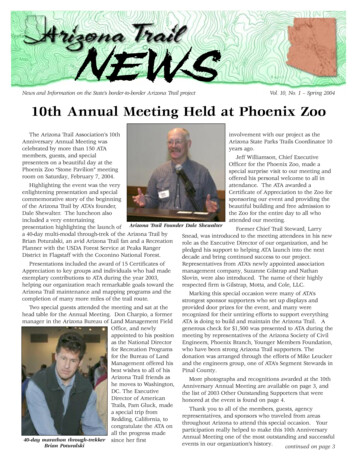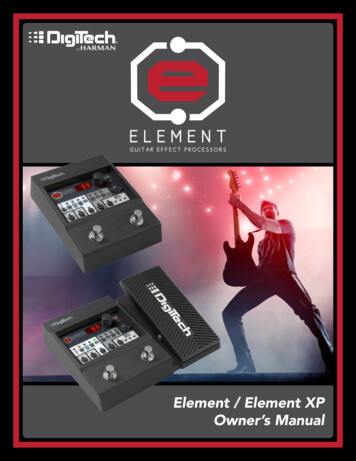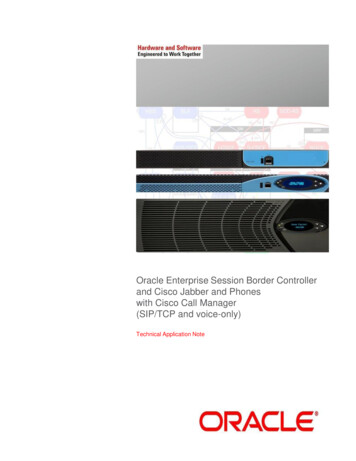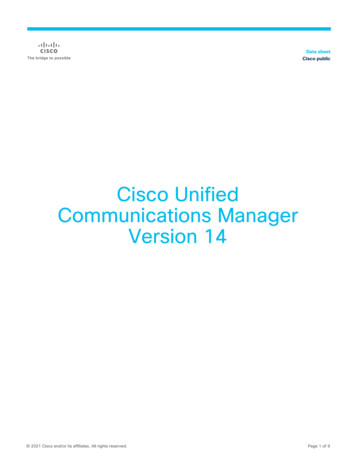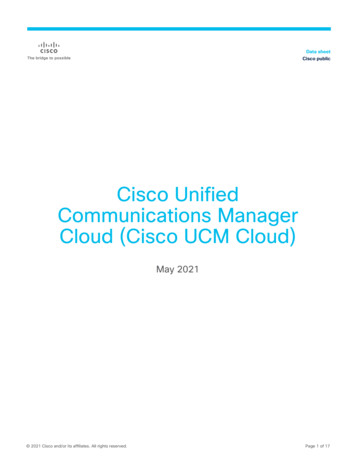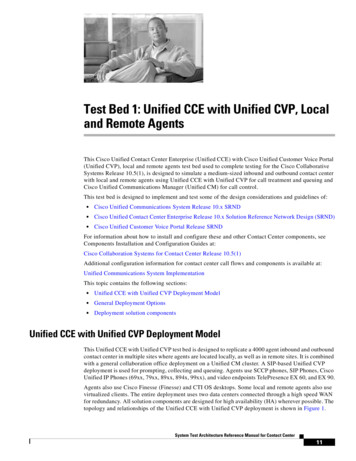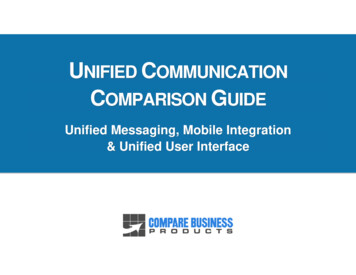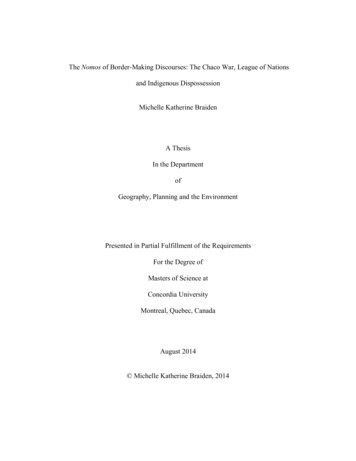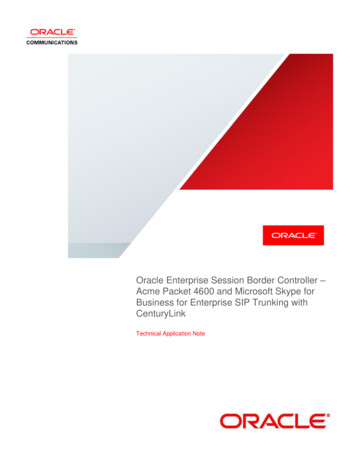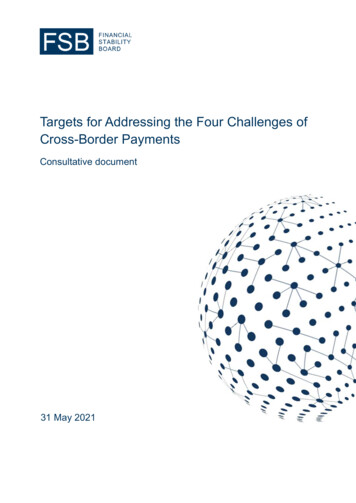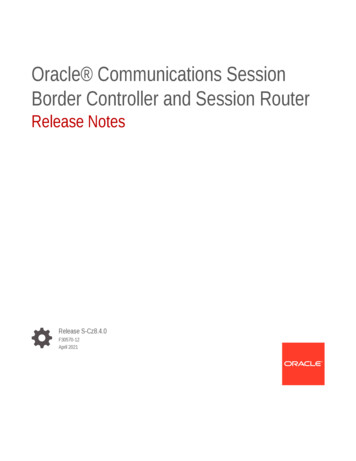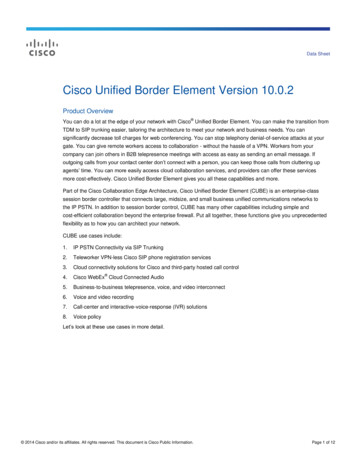
Transcription
Data SheetCisco Unified Border Element Version 10.0.2Product OverviewYou can do a lot at the edge of your network with Cisco Unified Border Element. You can make the transition fromTDM to SIP trunking easier, tailoring the architecture to meet your network and business needs. You cansignificantly decrease toll charges for web conferencing. You can stop telephony denial-of-service attacks at yourgate. You can give remote workers access to collaboration - without the hassle of a VPN. Workers from yourcompany can join others in B2B telepresence meetings with access as easy as sending an email message. Ifoutgoing calls from your contact center don’t connect with a person, you can keep those calls from cluttering upagents’ time. You can more easily access cloud collaboration services, and providers can offer these servicesmore cost-effectively. Cisco Unified Border Element gives you all these capabilities and more.Part of the Cisco Collaboration Edge Architecture, Cisco Unified Border Element (CUBE) is an enterprise-classsession border controller that connects large, midsize, and small business unified communications networks tothe IP PSTN. In addition to session border control, CUBE has many other capabilities including simple andcost-efficient collaboration beyond the enterprise firewall. Put all together, these functions give you unprecedentedflexibility as to how you can architect your network.CUBE use cases include:1.IP PSTN Connectivity via SIP Trunking2.Teleworker VPN-less Cisco SIP phone registration services3.Cloud connectivity solutions for Cisco and third-party hosted call control4.Cisco WebEx Cloud Connected Audio5.Business-to-business telepresence, voice, and video interconnect6.Voice and video recording7.Call-center and interactive-voice-response (IVR) solutions8.Voice policyLet’s look at these use cases in more detail. 2014 Cisco and/or its affiliates. All rights reserved. This document is Cisco Public Information.Page 1 of 12
IP PSTN Connectivity with SIP TrunkingThe benefits of unified communications and collaboration services will continue to grow as voice, video, and mobileservices become more pervasive elements of integrated collaboration solutions. However, these enhancementswill be available only if you deploy end-to-end real-time IP communications for both inter- and intracompany voiceand video services based on Session Initiation Protocol (SIP). This deployment will require transitioning yourservice provider network interconnect from time-division multiplexing (TDM) circuits to SIP trunking.The session border controller (SBC) has become a critical network component for scaling and securing unifiedcommunications networks. The SBC makes it possible to expand end-to-end IP connectivity for real-time voice andvideo through service provider SIP trunks or through a secure SIP session over the Internet to directly connect twoenterprise networks.Cisco Unified Border Element (CUBE) supports the transition to SIP trunking by enabling Cisco or third-party IPcall/session control to connect to and interoperate with service provider SIP trunk services. CUBE terminates andreoriginates both signaling (H.323 and SIP) and media streams (Real-Time Transport Protocol [RTP] and RealTime Control Protocol [RTCP]) to provide secure border interconnection services between IP networks. UsingCUBE, Cisco customers can save on their current network services, simplify their network architectures, andposition their networks for ongoing enhancements in collaboration services.As an integrated Cisco IOS Software application, CUBE runs on a broad range of Cisco router platforms,including the Cisco 800, 2900, 3900, and 4000 Series Integrated Services Routers (ISRs) as well as the CiscoASR 1000 Series Aggregation Services Routers (ASRs). The breadth of Cisco router platforms that support theCUBE feature license means that it provides unsurpassed price/performance scalability compared to otherenterprise SBCs. This scalability translates into network design flexibility for enterprise, midsize, and smallbusinesses. It also means operational efficiencies and a broader serviceable market for service providers thatinclude CUBE as part of their SIP trunk managed or hosted services.CUBE performs the following functions between the enterprise and service provider networks: Session control: The capability to offer flexible trunk routing, Call Admission Control (quality of service[QoS]), and resiliency and call accounting for the SIP sessions processed by the SBC Interworking: The capability to interconnect different signaling methods and media encoding variants forboth voice and video sessions Demarcation: The capability to act as a distinct demarcation point between two networks for address andport translation and to facilitate troubleshooting Security: The capability to intelligently allow or disallow real-time traffic between networks, and to encryptthe real-time traffic as appropriate for the applicationCUBE also enables flexible SIP interconnect: As a Cisco IOS Software feature set that runs on a broad range ofCisco routers (see complete list in Table 2, later in this document), CUBE enables great flexibility in how youdesign your SIP trunk network. Of course, this means your existing inventory of Cisco routers (as per the list inTable 2) can be repurposed for use as a CUBE platform. As a result you can deploy CUBE in centralized,distributed, or hybrid (combination of centralized and distributed) SIP architectures. This flexibility will be invaluableas collaboration use cases, such as conferencing, video, and mobility, evolve to place increased demands on theenterprise network. Many service providers have recognized their customers’ need to adapt their SIP trunkarchitecture as their collaboration services evolve, and they now offer multilocation SIP trunk pooling services.CUBE provides unsurpassed SBC price/performance flexibility so you can take advantage of these serviceofferings. 2014 Cisco and/or its affiliates. All rights reserved. This document is Cisco Public Information.Page 2 of 12
For SIP network deployments that require a centralized architecture, CUBE can be deployed to support highlyscalable, highly available configurations referred to as CUBE Clusters. CUBE Clusters are created by combiningCUBE with Cisco Unified SIP Proxy (CUSP), and can support up to 64,000 concurrent sessions in a single cluster.CUBE also enables simplified TDM-to-SIP migrations using the Cisco ISRs. For most enterprises, the transitionfrom TDM trunk services to SIP trunk services requires careful planning because this transition must be achievedwhile maintaining a functional voice network. This planning involves, among other things, addressing the serviceprovider requirement for number portability and the IT requirement for dial-plan revisions. CUBE can simplify thistransition, particularly for Cisco customers who already use the Cisco TDM Gateway on the Cisco 2900 and 3900Series ISR series. These routers can be easily upgraded-without requiring any additional hardware-to support theCUBE feature license, and they can concurrently support SIP trunking and TDM trunking. As a result, you cantransition your voice network to SIP trunking while retaining the existing TDM gateway functions. As you becomefamiliar and confident with SIP trunking, you can phase out the TDM Gateway function, or retain it as a highavailability redundant network strategy.Teleworker VPN-less SIP Phone Registration ServicesCisco Unified Border Element (CUBE) will allow remote Cisco SIP phones (Cisco Unified IP Phone 6900, 7800,7900, 8800, 8900, and 9900 Series models) to establish a secure application layer connection for both signaling(SIP-Transport Layer Security [TLS]) and media (Secure RTP [SRTP]) through the Internet and then perform aproxy registration of these phones with Cisco Unified Communications Manager, Cisco Business Edition, or CiscoHosted Collaboration Solution (Cisco HCS).Cloud Connectivity Solutions for Cisco and Third-Party Hosted Call Control Cisco Hosted Collaboration Solution (HCS) remote SIP phone registration services: Using CUBE,enterprises of all sizes can enjoy the collaboration benefits of Cisco HCS over the Internet. Using SIP TLSand SRTP, CUBE phone proxy services securely deliver all the capabilities of Cisco HCS without requiringa VPN. CUBE supports Cisco Unified IP Phone 6900, 7800, 7900, 8800, 8900, and 9900 Series models ofSIP phones. These services can include registration pass-through, voice-quality metrics, and 911preemption. Third-Party Hosted Call Control remote SIP phone registration services: Many service providers offerhosted call-control services to their small customers based on cloud-based private-branch-exchange (PBX)software, such as Broadsoft. Using the NANOCUBE licensing (refer to the “CUBE Licensing Options”section later in this document), Cisco 800 Series ISRs can be included as part of these hosted call-controlservices to perform gateway functions at the customer premises, such as registration pass-through, voicequality metrics, and 911 preemption.Cisco WebEx Cloud Connected AudioCisco WebEx Cloud Connected Audio (CCA) is a cost-effective audio conferencing solution for Cisco WebExmeetings and is enabled by CUBE. It extends the functions of Cisco Unified Communications Manager andincorporates on-premises equipment to connect your organization to a Cisco WebEx Cloud data center viadedicated peering connections. CUBE provides the high capacity SIP media connectivity to the WebEx cloud toreplace the TDM audio connection. It allows SIP sessions from all enterprise sites to connect to the Cisco WebExcloud and avoids media hairpinning to provide the most efficient network usage. 2014 Cisco and/or its affiliates. All rights reserved. This document is Cisco Public Information.Page 3 of 12
Business-to-Business Telepresence, Voice, and Video InterconnectCUBE provides secure connectivity for Cisco TelePresence deployments over SIP, either on a point-to-point basisover the Internet between two private enterprise networks or from a private enterprise network to a telepresenceservice provider.Voice and Video RecordingCUBE supports voice-recording solutions by providing various mechanisms to invoke media forking on a per callbasis. One method, which is SIP-based and is derived from the SIPREC standardization, sends a forked SIP inviteto the target recording application server, which can either accept or reject the call. An alternative method is anHTTP-based application programming interface (API) that allows the recording server to instruct CUBE to performthe media forking, and can toggle the media forking through the duration of an active call.Call-Center and IVR SolutionsCUBE provides numerous features to improve the performance of your enterprise call center. For example, itsupports midcall codec renegotiation, with either internal transcoding or external endpoints. CUBE also supportsSIP-based Call Progress Analysis for outbound call-center solutions, and runs concurrently on the ISR with theCisco IOS Software-based VoiceXML client to support IVR integration.Voice PolicyCUBE, as part of its complete SBC security function, supports policy-led evaluation of phone calls. This capabilityis becoming increasingly critical as incidents of telephony denial of service (TDoS) are more prevalent, asevidenced by the formal public warnings of such attacks being given by the U.S. Federal Bureau of Investigation(FBI) and Department of Homeland Security (DHS). CUBE enables highly flexible and granular voice-policysolutions to identify specific patterns of calling activity from either internal users (employees) or external callers andto take appropriate action when those patterns occur, including call termination, call redirection, and call recording.This voice-pattern recognition helps ensure that the full capacity of the enterprise voice network is used to supportthe business as intended.CUBE Licensing OptionsCUBE can be licensed according to the following three different licensing options: Standard CUBE Licensing: Standard licensing is used for CUBE licensing with all modular Cisco ISR andCisco ASR 1000 Series platforms to deliver the full range of CUBE functions, but without high availability.This license is per-session, and a session is defined as a two-way call through CUBE regardless of thenumber of media sessions involved in that call (that is, a video call with four media lines or sessions or anaudio call with two media lines or sessions). Redundant CUBE Licensing: Redundant licensing is used for CUBE with all modular Cisco ISR and CiscoASR 1000 platforms to deliver the full range of CUBE functions, including high availability with callpreservation between an active and standby CUBE. This licensing option also allows for license transferbetween two geographically distributed CUBE platforms, as in the scenario of a dual data centerdeployment strategy, where CUBE service redundancy without call preservation is satisfactory. NANOCUBE Licensing: NANOCUBE licensing is used only for Cisco 800 Series ISR and Cisco ServiceProvider Integrated Access Device (SP-IAD) platforms typically as part of a third-party (not based on CiscoHosted Collaboration Solution (HCS)) cloud hosted call-control solution. This licensing option also supportsother CUBE features, except to the extent that such features require additional hardware platform support,such as DSPs for transcoding. 2014 Cisco and/or its affiliates. All rights reserved. This document is Cisco Public Information.Page 4 of 12
More information about these licensing options can be obtained in the CUBE Ordering Guide available at:http://www.cisco.com/go/cube.CUBE Feature SupportCUBE supports protocols such as H.323 and SIP for both voice and video. Table 1 lists the features supported forvoice and video.Table 1.Cisco Unified Border Element Features (CUBE Versions Include 9.5.1 or Later)FeatureSupport D
Cisco ASR 1000 Series platforms to deliver the full range of CUBE functions, but without high availability. This license is per-session, and a session is defined as a two-way call through CUBE regardless of the number of media sessions involved in that call (that is, a video call with four media lines or sessions or an audio call with two media lines or sessions). Redundant CUBE Licensing .
